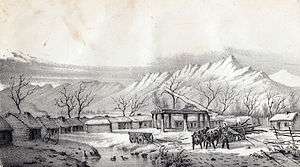Fort Utah

Fort Utah (also known as Fort Provo)[1] was the original settlement at Provo, Utah, United States and was established March 12, 1849. The original settlers were President John S. Higbee, and about 30 families or 150 persons that were sent from Salt Lake City to Provo by President Brigham Young. Several log houses were erected, surrounded by a 14-foot (4.3 m) palisade 20 by 40 rods in size (330 by 660 feet [100 by 200 m]), with gates in the east and west ends, and a middle deck, for a cannon. The fort was first located west of town, but was moved to Sowiette Park in April, 1850.[2][3]
Battle at Fort Utah
In early January 1850, three settlers accused a Ute man by the name of Old Bishop of stealing a shirt.[4] They murdered him and hid his body in the Provo River. The Utes demanded that the settlers turn over the murderers.[5] Brigham Young ordered an attack on the Utes,[6] telling them to kill all the men and take the women and children captive. On February 8, 1850, a militia from Salt Lake surrounded a group of around seventy people at Big Elk. After two days of fighting, the Utes surrendered. The army killed the men and sent the women and children up to Salt Lake as prisoners. This further angered the Utes, which eventually led to the Walker War.[7]
References
- ↑ "Chapter Twenty-Seven: Establishing a Refuge in Deseret". lds.org. Salt Lake City: The Church of Jesus Christ of Latter-day Saints. 2003. Retrieved 30 Mar 2016.
Fort Utah was also called Fort Provo in honor of Etienne Provot, an early French trapper.
- ↑ "Fort Utah". provolibrary.com. Provo City Library. Retrieved 30 Mar 2016.
- ↑ Weiser, Kathy (Aug 2011). "Utah Forts of the Old West - Page 2". legendsofamerica.com. Retrieved 30 Mar 2016.
- ↑ Peace and Violence among 19th-Century Latter-day Saints
- ↑ Peace and Violence among 19th-Century Latter-day Saints
- ↑ An account of the dialogue of the January 31 meeting can be found in BYC, Microfilm reel 80, box 47, folder 6. Brigham Young is quoted as stating: "I say go [and] kill them. . . . Tell Dimick Huntington to go and kill them—also Barney Ward—let the women and children live if they behave themselves. . . . We have no peace until the men [are] killed off—never treat the Indian as your equal." Wells's Special Order No. 2 can be found in the Utah State Archives, State Capitol, Salt Lake City, Utah Territorial Militia Correspondence, 1849-1863, ST-27, Microfilm reel 1, Document No. 5
- ↑ Utah Historical Quarterly Volume XLVI 0pen Hand and Mailed Fist: Mormon-Indian Relations in Utah, 1847-52 by Howard A. Christy
Further reading
- Carter, D. Robert (2003), Founding Fort Utah: Provo's Native Inhabitants, Early Explorers, and First Year of Settlement, Provo, Utah: Provo City Corporation, ISBN 1-57636-151-9
- Colton, Ray C. (1946), A Historical Study of the Exploration of Utah Valley and the Story of Fort Utah, Master's thesis, Provo, Utah: Brigham Young University
- Stansbury, Captain Howard (Corps of Topographical Engineers, U.S. Army) (1852), Exploration and Survey of the Valley of the Great Salt Lake of Utah, Washington, D.C.: United States Senate (Special Session, March, 1851, Executive Document #3)
.png)